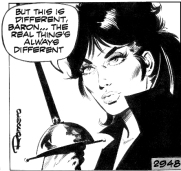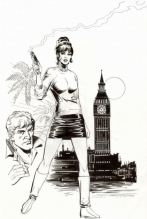Pages
- Home
- 2000 AD
- Charlton Comics Collection
- Comics Compilations made by Voltaire57
- Classic Comics/Classics Illustrated
- Contributions by Jens Terje
- Fiction House Comics [Complete series]
- Four Color Dell #0001 - #1354 (1942 - 1962) Series
- Misty Compilations
- Tammy Compilations
- The Victor #0001 - #1675. D.C. Thomson, 1961
- Thriller Comics Library
Search This Blog
Monday, 11 October 2021
Joe Palooka - Sunday Strips 1934 - 1955 - Ham Fisher
Thursday, 7 October 2021
Joe Palooka - Daily Strips 1930 - 1952 - Ham Fisher
Monday, 28 June 2021
Modesty Blaise 51-96 (Peter O'Donnell et alii) Strips
Author: Peter O'Donnell
Illustrators: Jim Holdaway, Enrique Badía Romero, John M. Burns,
Patrick Wright, Neville Colvin, Dan Spiegle, Dick Giordano
Current status/schedule : Finished
Launch date 13 May 1963 End date 7 July 2002
Monday, 21 June 2021
Modesty Blaise 00-50 (Peter O'Donnell et alii) Strips
Author: Peter O'Donnell
Illustrators: Jim Holdaway, Enrique Badía Romero, John M. Burns,
Patrick Wright, Neville Colvin, Dan Spiegle, Dick Giordano
Current status/schedule : Finished
Launch date 13 May 1963 End date 7 July 2002
Modesty Blaise is a British comic strip featuring a fictional character of the same name, created by author Peter O’Donnell and illustrator Jim Holdaway in 1963. The strip follows Modesty Blaise, an exceptional young woman with many talents and a criminal past, and her trusty sidekick Willie Garvin. It was adapted into films in 1966, 1982, and 2003, and from 1965 onwards eleven novels and two short story collections were written.
In 1945, a nameless girl escapes from a displaced person (DP) camp in Kalyros, Greece. She remembers nothing from her short past and wanders through post-World War II Mediterranean, the Middle East, and regions of North Africa, where she learns to survive the hard way. She befriends Lob, another wandering refugee who is a Jewish Hungarian scholar from Budapest. He gives her an education and a first name: Modesty. Sometime later Modesty creates her last name, Blaise, after Merlin’s tutor from the Arthurian legends. When Lob dies is unclear, other than it being prior to her going to Tangier. In ‘The Xanadu Tailisman’ it is mentioned that Modesty has left Lob at a village to recover from a wound; she goes alone to sell a car tyre. In 1953 she takes control of a criminal gang in Tangier from Henri Louche and expands it into an international organization called the Network.
Having conceived the idea after a chance meeting with a girl during his wartime service in the Middle East, O’Donnell elected to work with Jim Holdaway, with whom he had worked on the strip Romeo Brown, after a trial period of collaboration with Frank Hampson, creator of Dan Dare, left O’Donnell dissatisfied. Modesty Blaise debuted in the London Evening Standard on 13 May 1963. The strip was syndicated among a large number of newspapers ranging from the Johannesburg Star to the Detroit Free Press, the Bombay Samachar, The Telegraph (Calcutta, India), The Star (Malaysia), The West Australian (Perth) and The Evening Citizen (Glasgow, Scotland).
After Jim Holdaway’s death in 1970, the art of the strip was provided by the Spanish artist Enrique Badía Romero. Eight years later, Romero quit to make time for his own comics projects, and after short attempts by John Burns and Patrick Wright, Neville Colvin drew the strip until 1986. Then Romero returned to the job and continued until the end of the strip.
 The strip’s circulation in the United States was erratic, in part because of the occasional nude scenes, which were much less acceptable in the US than elsewhere, resulting in a censored version of the strip being circulated. (Modesty occasionally used a tactic that she called the “Nailer,” in which she would appear topless, distracting the bad guys long enough to give Willie or herself a chance to incapacitate them.) An example of this censorship appears in the introduction to the 2007 Titan Books reprint volume Death Trap, which illustrated two segments of the story arc, “The Junk Men” that were censored by the Detroit Free Press when it published the strip in 1977; in both cases a screen was drawn over scantily-clad images of Willie and Modesty. Reportedly, O’Donnell did not approve of the changes, although they were made by the artist, Romero.
The strip’s circulation in the United States was erratic, in part because of the occasional nude scenes, which were much less acceptable in the US than elsewhere, resulting in a censored version of the strip being circulated. (Modesty occasionally used a tactic that she called the “Nailer,” in which she would appear topless, distracting the bad guys long enough to give Willie or herself a chance to incapacitate them.) An example of this censorship appears in the introduction to the 2007 Titan Books reprint volume Death Trap, which illustrated two segments of the story arc, “The Junk Men” that were censored by the Detroit Free Press when it published the strip in 1977; in both cases a screen was drawn over scantily-clad images of Willie and Modesty. Reportedly, O’Donnell did not approve of the changes, although they were made by the artist, Romero.
The final Modesty Blaise strip ran in the Evening Standard on 11 April 2001. Some of the newspapers that carried the series, feeling that it had become a tradition for their readers, began running it again from the beginning. O’Donnell, to give Romero some additional work, gave the artist permission to adapt one of his short stories (“The Dark Angels”) as a graphic novel that was published in Scandinavia in 2002, later being reprinted in the US in a special issue of Comics Revue.
From 1 December 2008, the Evening Standard, which had stopped including comic strips for some time, republished La Machine, using the original artwork. Following a change of ownership of the paper, they did not continue with subsequent stories.
The ordinary strips are consecutive numbered from 1 to 10183. Outside this numbering are the two newspaper stories “In the Beginning” and “The Killing Ground” and the two comic book stories “Modesty Blaise” and “The Dark Angels”.
Outside the ordinary numbering is also an amount of A-strips. An A-strip has the same number as the previous strip but followed by an A. They were used on days when not all the newspapers running Modesty Blaise were published. An A-strip is not vital for the continuity of the story and is often just supplementing the previous strip.
The first A-strip was 194A and was published during Christmas 1963 in Scottish newspapers.
Since December 1974 The Evening Standard has not been published on Saturdays. So, since then, and the story “Cry Wolf”, a sixth of the strips have been A-strips and have not had their premiere in The Evening Standard.
https://newspapercomicstripsblog.wordpress.com/2016/03/05/modesty-blaise/
Friday, 2 August 2019
The Andy Capp Collection Strips (2001-2014) Reg Smythe
Andy Capp is a British comic strip created










































